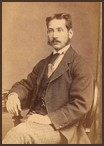Ella Cinders
was a syndicated comic strip created by writer Bill Conselman and artist Charles Plumb. Distributed by United Feature Syndicate, the daily version was launched June 1, 1925, and a Sunday page followed two years later. It was discontinued in 1961. Chris Crusty ran above Ella Cinders as a topper strip from 1931 to 1940.
Initially, as the name implies, the strip presented a variation on the classic Cinderella story, but then it diverged into other plotlines, as noted by comics historian Don Markstein:
Ella was the stepdaughter of Myrtle “Ma” Cinders, a formidable woman who assigned Ella to the household drudge work while her own daughters, Prissie (“pinched and acid”, to quote Conselman’s description of his character) and Lotta (“fat and foolish”) Pill spent their copious free time tormenting Ella. But Ella wasn’t the sort to let that get her down. With her kid brother Blackie as an ally, she wisecracked her way through the most depressing of situations, finding solace in sarcasm. Outside the house, she had a boyfriend with the improbable name of Waite Lifter. She was pretty enough, in a 1920s sort of way, with straight, black hair and as big and bright a pair of eyes as you’ll find anywhere in comics. But she wasn’t a raving beauty, and tended to dress down, especially in the early years. Her “fairy godmother” moment did come in the form of winning a beauty contest, but that was only because the guy judging it picked her photo at random. The prize was relocation to Hollywood and a glamorous job at a movie studio. When she got there she found the studio defunct, but at least she was out of the “Cinderella” situation. For the next few years, Ella and Blackie kicked around Hollywood, doing melodramatic continuity in the dailies and one-episode gags on Sundays. She never really prospered, but did okay for herself—in fact, she even got married, though her husband, Patches, spent a lot of time away, having adventures.
A film adaptation of the comic strip Ella Cinders, directed by Alfred E. Green, starring Colleen Moore, produced by her husband John McCormick (1893-1961), and co-starring Moore's most popular co-star, Lloyd Hughes.
In the house of late father, Ella Cinders (Colleen Moore) works for her stepmother and two stepsisters, Prissy Pill (Emily Gerdes) and Lotta Pill (Doris Baker), finding support from the local iceman, Waite Lifter (Lloyd Hughes). The Gem Film Company has a contest in which the winner gets an all-expense paid trip to Hollywood and a movie role. A photograph is needed to enter, so Ella spends three nights babysitting to raise $3 for the photo session.
However, the photographer unwittingly take a picture of her looking cross-eyed at a fly on her nose which turns out to be the photo entered in the contest. Entrants must go to a Town Hall ball, but Ella's stepmother and stepsisters won't allow her to go. Waite sees her crying on the front steps and tells her he will take her to the ball. She says she has nothing to wear, so he convinces her to use one of her stepsisters' dresses. At the judges' table, her stepsisters react violently when they see the dress. The embarrassed Ella flees the ball, losing one of her slippers.
Later, the judges come to the house and tell Ella that she is the winner because they were amused by the cross-eyed photo. Ella heads for Hollywood, where she is disappointed to discover the contest was a fraud. She nevertheless manages to land a movie contract. Waite turns out to be football hero George Waite, and the two are reunited.
(en.wikipedia.org)

 RSS Feed
RSS Feed


